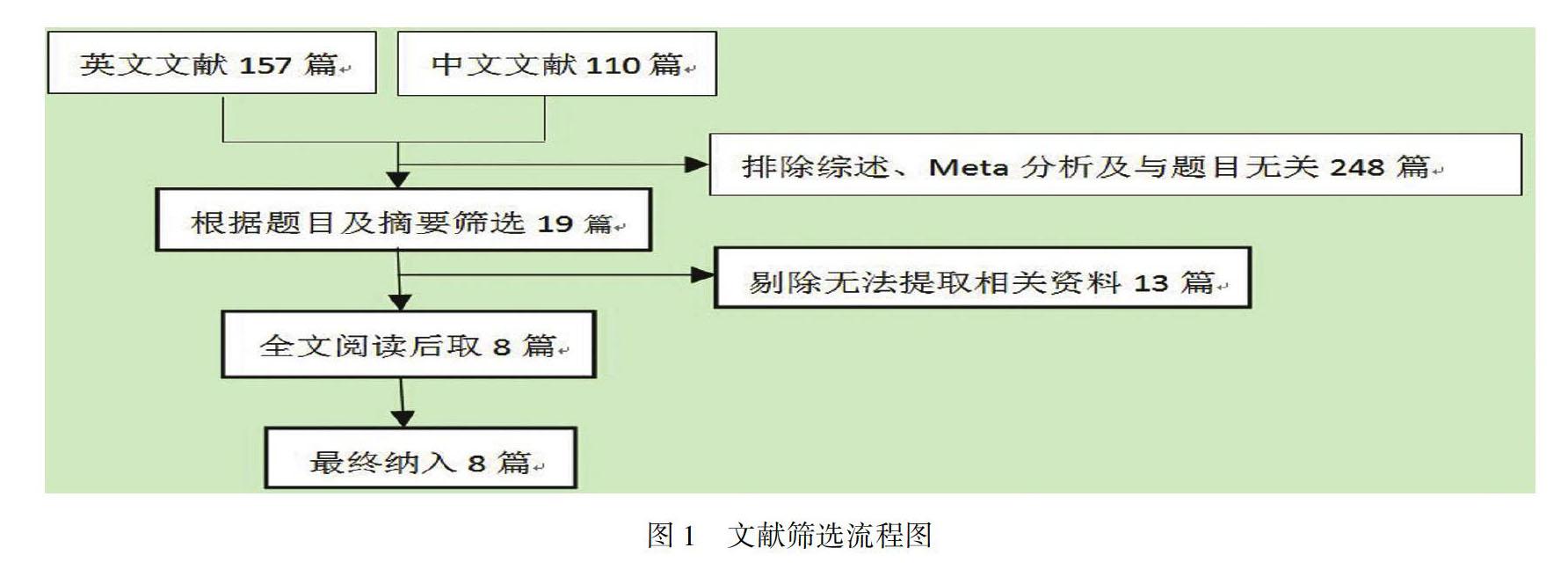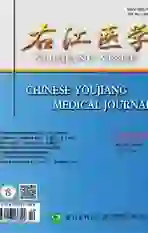直接前入路与前外侧入路在人工全髋关节置换术后临床疗效的Meta分析
2019-12-09陈金忠黄建婷杨埜李野韩超刘佳谢克恭唐毓金
陈金忠 黄建婷 杨埜 李野 韩超 刘佳 谢克恭 唐毓金



【摘要】 目的 系统地比较直接前入路(DAA)与前外侧入路(ALA)在人工全髋关节置换术的临床疗效。
方法 计算机检索PubMed、Embase、Cochrane、知网、万方、维普等数据库(自建库以来到2019年7月)关于DAA与ALA髋关节置换术后临床疗效对照研究文献,按照纳入与排除标准进行筛选文献提取数据,并对文献质量进行评估。采用Review manager 5.2进行Meta分析,比较DAA与ALA临床疗效的差异,主要分析指标包括并发症(股外侧神经损伤、周围骨折)、影像学表现(前倾角、髋臼杯外展角)、术后髋关节功能Harris评分,次要指标为术中出血量、手术时间、住院时间。
结果 共有8篇文献、730例患者纳入研究。研究结果显示两组患者周围骨折[RR=2.02,95%CI(0.45~9.10),P=0.36]、前倾角[WMD=2.22,95%CI(-0.06~4.51),P=0.06]、髋臼杯外展角[WMD=0.66,95%CI(-0.38~1.71),P=0.21]、术后髋关节Harris评分[WMD=0.47,95%CI(-2.71~3.66),P=0.77]、手术时间[WMD=-0.44,95%CI(-1.14~0.26),P=0.22]、手术切口[WMD=-1.18,95%CI(-2.89~0.51),P=0.17]等方面差异无统计学意义;DAA入路股外侧神经损伤发生率高于ALA入路[RR=3.79,95%CI(1.43~10.01),P=0.007],但术中出血量少于ALA入路[WMD=-75.15,95%CI(-107.30~-43.00),P<0.001],患者住院时间短于ALA入路[WMD=-2.30,95%CI(-4.24~-0.36),P=0.02]。
结论 两种入路在影像学表现、术后髋关节功能Harris评分、手术时间、术口长度等方面无显著差异,但DAA入路术中出血量少,住院时间短,两者在并发症方面DAA入路股外侧神经损伤发生率高,但周围骨折发生率两者均较低,差异不明显。纳入研究异质性较大,结果需要更高质量对照研究进一步验证。
【关键詞】 髋关节置换术;直接前入路;前外侧入路;Meta分析
中图分类号:R687.4 文献标志码:A DOI:10.3969/j.issn.1003-1383.2019.10.003
Meta-analysis of clinical efficacy of direct anterior approach and anterolateral approach after total hip arthroplasty
CHEN Jinzhong,HUANG Jianting,YANG Ye,LI Ye,HAN Chao,LIU Jia,XIE Kegong,TANG Yujin
(Department of Spinal Joint Osteopathy,Youjiang Medical University for Nationalities,Baise 533000,China)
【Abstract】 Objective To systematically compare the clinical outcomes of direct anterior approach(DAA) and anterior lateral approach(ALA) in total hip arthroplasty.
Methods Controlled research literatures on the clinical effects of DAA and ALA hip arthroplasty were searched from PubMed,Embase,Cochrane,CNKI,Wanfang,Weipu and other databases(since the establishment of the databases until July,2019).According to inclusion and exclusion criteria,the literatures were screened and extracted,and the quality of them were evaluated.Meta-analysis was conducted by Review Manager 5.2,and the difference of clinical efficacy between DAA and ALA was compared.The main analysis indexes were complications(lateral femoral nerve injury and peripheral fracture),imaging findings(anterior dip angle,acetabular cup abduction angle) andpostoperative Hip function Harris score.Secondary analysis indexes were intraoperative blood loss,operation time and hospital stay.
Results A total of 8 articles and 730 patients were included in the study.The results of the study showed that there were no statistically significant differences in peripheral fractures[RR=2.02,95%CI(0.45~9.10),P=0.36],anteversion angles[WMD=2.22,95%CI(-0.06~4.51),P=0.06],hip cup abduction angles[WMD=0.66,95%CI(-0.38~1.71),P=0.21],postoperative hip joint Harris scores[WMD=0.47,95%CI(-2.71~3.66),P=0.77],operation time [WMD=-0.44,95%CI(-1.14~0.26),P=0.22],and surgical incisions[WMD=-1.18,95%CI(-2.89~0.51),P=0.17]between the two groups.The incidence of lateral nerve injury in the DAA approach was higher than that in the ALA approach[RR=3.79,95%CI(1.43~10.01),P=0.007],but the intraoperative blood loss was less than that in the ALA approach[WMD=-75.15,95%CI(-107.30~-43.00),P<0.001],patient hospitalization time was shorter than that in the ALA approach [WMD=-2.30,95%CI(-4.24~-0.36),P=0.02].
Conclusion There are no significant differences between the two approaches in imaging findings,postoperative hip function Harris score,operation time and the length of the operation opening.However,the DAA approach has less bleeding and shorter hospital stay.The incidence of lateral nerve injury in the DAA approach is high,but the incidence of peripheral fractures in both approaches is low,difference is not significant.The heterogeneity of the inclusion study is large,and the results need to be further verified by higher quality control studies.
【Key words】 total hip arthroplasty;direct anterior approach;anterior lateral approach;Meta analysis
髋关节置换术(Total hip arthroplasty,THA)是现代医学最成功的骨科手术之一,应用于临床已有百年歷史。THA入路有直接前入路(Direct anterior approach,DAA)、外侧入路[前外侧入路(Anterior lateral approach,ALA)、直接外侧入路、后外侧入路]、后路入路。但目前THA最有效的手术方法仍存在争议。2010年从全球整形外科登记处提取的数据表明,55%和33%的THA分别采用后路入路和ALA进行[1]。自2013年以来,10%的骨科关节成形外科医生认为DAA入路是他们的首选方法[2]。DAA与ALA是THA中常用的微创入路,在一些临床队列研究中发现具有更低的脱位风险、早期步态改善及疼痛少等优势[3]。但在一项关于THA入路的网状Meta分析发现,DAA与ALA能有效提高视觉模拟评分(VAS)及Harris评分,但从并发症来分析,后路发生率最低,其次是外侧,最差的是前入路[4]。既往文献中有较多关于THA不同入路临床疗效的研究,关于DAA与ALA比较的文献数量较少。最近有一篇关于DAA与ALA的荟萃分析[5],纳入9篇文献,但比较的指标是步态分析,纳入的标准存在将外侧入路笼统归于前外侧入路。本Meta分析严格按纳入与排除标准筛选文献,结合国内外文献,通过分析并发症(股外侧神经损伤、周围骨折)、影像学表现(前倾角、髋臼杯外展角)、髋关节功能Harris评分、手术时间、术口长度、术中出血量、住院时间,系统地比较DAA与ALA临床疗效。
1 资料与方法
1.1 文献检索
计算机检索PubMed、Embase、Cochrane、知网、万方、维普等数据库,手工检索已发表关于DAA与ALA在人工髋关节置换术临床疗效比较的文献,限定文献种类为英文或中文,使用的中文关键词:髋关节置换术、关节成形术、直接前入路、前入路、前外侧入路。英文关键词:Hip replacement,Total hip arthroplasty,Direct anterior approach(DAA),Anterior lateral approach(ALA)。
1.2 纳入及排除标准
纳入标准:①研究设计为队列研究(随机对照或回顾性研究);②研究人群为成人且因髋关节病变(原发性骨性关节炎或缺血性坏死)需行THA患者;③干预:DAA或ALA全髋关节置换术;④可以有效提取观察指标。排除标准:①非中英文全文;②书信、摘要、综述、Meta分析、会议论文、个案报道及重复发表的文献;③双切口;④无法提取观察指标。
1.3 文献质量评估
采用改良JADAD评分表对每篇文章进行质量评估,主要基于随机系列、随机化隐藏、盲法及随访期间撤退与退出进行评分(1~3分视为低质量,4~7分视为高质量)。
1.4 统计学方法
运用RevMan 5.2软件对提取的数据进行Meta分析。对于计量资料以加权均数差(weighted mean difference,WMD)和95%可信区间(confidence interval,CI)为效应指标进行分析,而计数资料则以相对危险度(risk ratio,RR)及其95%CI为效应指标。检验水准:α=0.05,双侧检验。在合并研究时异质性检验采用I2检验,当研究无统计学异质性时(P>0.05,I2≤50%),采用固定效应模型进行分析。若出现统计学异质性时(P≤0.05,I2>50%),采用随机效应模型,并尽可能找出异质性来源,敏感性分析处理判断Meta结果的稳健性。Meta分析结果以森林图展示。缺少标准差数据,只描述均值、极值、样本量的文献,采用Hozo[6]计算标准差并纳入本次研究。
2 结果
2.1 文献检索结果
按照纳入及排除标准进行文献筛选,提取资料内容:第一作者姓名、发表年份、地域、术后髋关节功能Harris评分(6周、6个月)、并发症(股外侧神经损伤、周围骨折)、影像学表现(前倾角、髋臼杯外展角)、术中出血量、手术时间、住院时间。纳入本次分析的文献有8篇,共计730例患者。具体文献筛选流程见图1,具体纳入资料见表1。
2.2 Meta分析结果
2.2.1 股外侧神经损伤
共有6篇文献、569例纳入研究,各研究之间无显著异质性(P=0.41,I2=1%),采用固定效应模型,效应量合并分析指标选用RR,DAA入路股外侧损伤发生率高,差异有统计学意义[RR=3.79,95%CI(1.43~10.01),P=0.007]。见图2。
2.2.2 周围骨折
共有3篇文献、407例纳入研究,各研究之间无显著异质性(P=0.78,I2=0),采用固定效应模型,效应量合并分析指标选用RR,结果显示两种手术入路出现周围假体骨折发生率相当,差异无统计学意义[RR=2.02,95%CI(0.45~9.10),P=0.36]。见图3。
2.2.3 前倾角
术后采用标准髋关节正位片作为评估依据,共有4篇文献493例纳入研究,各研究之间存在异质性(P<0.001,I2=90%),采用随机效应模型,效应量合并分析指标选用WMD。结果显示,两种入路术后测量的前倾角差异无统计学意义 [WMD=2.22,95%CI(-0.06~4.51),P=0.06]。见图4。
2.2.4 髋臼杯外展角
术后采用标准髋关节正位片作为评估依据,正常范围为30°~50°,共有3篇文献、433例纳入研究,研究之间无异质性(P=0.27,I2=24%),采用固定效应模型,效应量合并分析指标选用WMD。结果显示两种入路并不影响髋臼外展角,差异无统计学意义[WMD=0.66,95%CI(-0.38~1.71),P=0.21]。见图5。
2.2.5 术后Harris评分
共有3篇文献242例患者纳入研究,各研究间无显著异质性(P=0.18,I2=42%),采用固定效应模型,效应量合并分析指标选用WMD。结果显示,术后6个月髋关节Harris评分在两种手术入路中差异无统计学意义[WMD=0.47,95%CI(-2.71~3.66),P=0.77]。见图6。
2.2.6 手术时间
共有6篇文献387例纳入研究,各研究间存在显著异质性(P<0.001,I2=90%),采用随机效应模型,效应量合并分析指标选用WMD。结果显示,两种手术方式手术时间差异无统计学意义[WMD=-0.44,95%CI(-1.14~0.26),P=0.22]。见图7。
2.2.7 术中出血量
共有5篇文献228例纳入研究,各研究之间存在异质性(P<0.001,I2=67%),采用随机效应模型,效应量合并分析指标选用WMD。结果显示,与ALA相比,DAA术中出血量较少 [WMD=-75.15,95%CI(-107.30~-43.00),P<0.001]。见图8。
2.2.8 切口长度
共有5篇文献354例纳入研究,各研究间存在显著异质性(P<0.001,I2=95%),采用随机效应模型,效应量合并分析指标选用WMD。结果显示,两种手术方式的手术切口长度相当,差异无统计学意义[WMD=-1.18,95%CI(-2.86~0.51),P=0.17]。见图9。
2.2.9 住院时间
共有3篇文献244例患者纳入研究,各研究间存在显著异质性(P<0.001,I2=90%),采用随机效应模型,效应量合并分析指标选用WMD。结果显示,经DAA入路行THA的患者住院时间较ALA入路的患者短,差异有统计学意义[WMD=-2.30,95%CI(-4.24~-0.36),P=0.02]。见图10。
2.3 发表偏倚
由于手术时间纳入研究的文献是所有二分类变量中最多的,所以用该指标的漏斗图分析发表偏倚,结果表明该研究的发表偏倚较明显。见图11。
3 讨论
现代THA的发展始于20世纪50年代,是改善髋关节功能最可靠的手术干预措施之一。2010年的一项流行调查研究表明,美国每年接受近332 000例THA,预计在未来的几十年,数量还会不断增长[15]。THA可以采用多种手术入路进行,有后路、直接外侧入路、DAA、ALA以及双切口入路。1917年,史密斯-彼得森首次描述DAA入路,1949年首次用于THA[16~17]。ALA入路也称Watson Jones方法,由Watson Jones[18]在1936年描述,与DAA入路为常用的微创方法。与后入路或直接外侧相比,DAA入路与ALA入路是经肌间隙暴露髋关节,最大限度减少肌肉损伤,有效减少术中出血量及术后疼痛,早期恢复功能锻炼[19~20]。目前关于DAA与ALA的队列研究较少,近几年研究得出的结果部分是相互矛盾的,最近一篇DAA与ALA的Meta分析比较了两者术后步态的差异性,得出的結论是无论何种手术方式,患者术后的步态均有改善,两者之间无显著差异,但并没有涉及其他方面的分析[5]。
术后髋关节功能的改善程度与并发症发生率(周围骨折、脱位、股外侧神经损伤)往往是患者与医生最为关注的问题,而术中周围假体骨折以及假体安放错误往往是毁灭性的。股外侧神经损伤可导致患者局部皮肤感觉障碍,本次研究结果显示DAA入路发生率显著高于ALA入路,由于DAA入路的特殊性,在向髋关节的远端延伸分离时,股四头肌群前外侧部分的神经血管损伤发生率显然高于其他入路[21]。虽然本次研究发现两者在周围骨折方面并无明显差异,但由于样本量少,异质性大,能够解释的范围较小。该研究结果显示两种入路术后Harris髋关节功能评分并无明显差异。但许多学者发现DAA入路手术在手术后的前六周,Harris髋关节评分均高于前外侧、直接外侧等其他入路,但随着患者功能锻炼逐渐加强后,在术后的3个月、6个月Harris髋关节评分并无明显差异,其原因可能与外展肌的分离和再附着在术后6周ALA较DAA恢复慢相关[5,22]。因此,DAA入路对于功能恢复的优势可能仅限于早期以及轻微的活动,就算两种方法的THA术后步态异常仍然存在,但这可能是由于其他因素引起,如术前步态适应[23]。髋臼组件定位对THA术后髋关节稳定性有重要影响,髋臼外展角和前倾角的术后影像学测量是评估髋臼组件朝向常用方法。Lewinnek等[24]定义髋臼杯和前倾角在30°~50°和5°~25°为安全区,该安全区将THA术后不稳定降至最低,本次研究结果提示两种手术入路可能都不影响假体的安放,更多取决于术者的经验。手术时间主要取决于术者对手术步骤及解剖的熟练程度。虽然本次研究提示两者手术时间差异并无统计学意义,但在很多研究中已经描述了DAA法的陡峭学习曲线,与后入路或直接外侧入路相比手术时间显著增加,并且易发生其他手术入路不常见的并发症,例如假体周围骨折、股外侧神经损伤,这可能与学习曲线有关,也可能与暴露不足有关[25~26]。通过使用现代麻醉技术、术中止血技术和术中常规使用一些止血药,无论何种手术方法,都应该有最小的失血量。该研究发现在术中出血量方面的差异有统计学意义,这可能与手术者的熟练程度及组织分离程度相关。正如Rodriguez等[27]报道的那样,与直接外侧入路相比,DAA减少了术中失血,其中切口越长,软组织分离越多,出血量可能越多,并且可能伴随外展肌的损伤。住院时间受许多因素的影响,由于出院所需的康复方案的性质各不相同,外科医生的决定、患者的期望值、患者经济能力、床位压力都可能影响到患者住院时间,虽然在整个研究中住院时间的差异有统计学意义,但并不足以说明DAA更有利于缩短患者住院时间。
本次研究納入文献较少,各个研究存在的异质性较大,徐亦鹏等[7]研究中DAA采用的是Bikini入路,可能增加各个研究之间的异质性,另外各个研究之间体重指数差异较大也可能增加异质性。考虑到这次Meta分析的局限性,需要更多高质量的随机对照研究来进一步确定DAA与ALA的临床疗效。
参 考 文 献
[1]Waddell J,Johnson K,Hein W,et al.Orthopaedic practice in total hip arthroplasty and total knee arthroplasty:results from the Global Orthopaedic Registry (GLORY)[J].Am J Orthop,2010,39(9 Suppl):5-13.
[2]Chechik O,Khashan M,Lador R,et al.Surgical approach and prosthesis fixation in hip arthroplasty world wide[J].Arch Orthop Trauma Surg,2013,133(11):1595-1600.
[3]De Anta-Díaz B,Serralta-Gomis J,Lizaur-Utrilla A,et al.No differences between direct anterior and lateral approach for primary total hip arthroplasty related to muscle damage or functional outcome[J].Int Orthop,2016,40(10):2025-2030.
[4]Putananon C,Tuchinda H,Arirachakaran A,et al.Comparison of direct anterior,lateral,posterior and posterior-2 approaches in total hip arthroplasty:network meta-analysis[J].Eur J Orthop Surg Traumatol,2018,28(2):255-267.
[5]Meermans G,Konan S,Das R,et al.The direct anterior approach in total hip arthroplasty:a systematic review of the literature[J].Bone Joint J,2017,99-B(6):732-740.
[6]Müller M,Tohtz S,Springer I,et al.Randomized controlled trial of abductor muscle damage in relation to the surgical approach for primary total hip replacement:minimally invasive anterolateral versus modified direct lateral approach[J].Arch Orthop Trauma Surg,2011,131(2):179-89.
[7]徐亦鹏,孙绍婷,王佳佳,等.不同手术入路行初次人工全髋关节置换术的近期疗效比较[J].中国修复重建外科杂志,2017,31(4):397-403.
[8]王瑞,胡成栋,李东风,等.全髋关节置换术中直接前方入路和前外侧入路的疗效对比研究[J].河北医科大学学报,2018,39(11):1270-1274.
[9]张志远,张跃正,吴仁政.全髋关节置换术中直接前方入路和前外侧入路的疗效对比研究[J].世界复合医学,2019,5(4):58-60.
[10]李森磊,杨先腾,田晓滨,等.直接前入路和前外侧入路全髋关节置换术后的早期功能恢复对比[J].北京大学学报(医学版),2019,51(2):268-272.
[11]Takada R,Jinno T,Miyatake K,et al.Direct anterior versus anterolateral approach in one-stage supine total hip arthroplasty.Focused on nerve injury:A prospective,randomized,controlled trial[J].J Orthop Sci,2018,23(5):783-787.
[12]Mayr E,Nogler M,Benedetti MG,et al.A prospective randomized assessment of earlier functional recovery in THA patients treated by minimally invasive direct anterior approach:a gait analysis study[J].Clin Biomech (Bristol,Avon),2009,24(10):812-818.
[13]Kawarai Y,Iida S,Nakamura J,et al.Does the surgical approach influence the implant alignment in total hip arthroplasty? Comparative study between the direct anterior and the anterolateral approaches in the supine position[J].International Orthopaedics,2017,41(12):2487-2493.
[14]Debi R,Slamowicz E,Cohen O,et al.Acetabular cup orientation and postoperative leg length discrepancy in patients undergoing elective total hip arthroplasty via a direct anterior and anterolateral approaches[J].BMC Musculoskeletal Disorders,2018,19(1):188.
[15]Maradit Kremers H,Larson DR,Crowson CS,et al.Prevalence of total hip and knee replacement in the United States[J].Bone Joint Surg Am,2015,97(17):1386-1397.
[16]Smith-Petersen MN.A new supra-articular subperiosteal approach to the hip joint [J].Journal of Bone & Joint Surgery,1917,s2-15(8):592-595.
[17]Smith-Petersen M.Approach to and exposure of the hip joint for mold arthroplasty[J].J Bone Joint Surg Am,1949,31A(1):40-46.
[18]Watson-Jones R.Fractures of the neck of the femur[J].Br J Surg,1936,23:787-808.
[19]Brismar BH,Hallert O,Tedhamre A,et al.Early gain in pain reduction and hip function,but more complications following the direct anterior minimally invasive approach for total hip arthroplasty:a randomized trial of 100 patients with 5 years of follow up[J].Acta Orthop,2018,89(5):484-489.
[20]Yue C,Kang P,Pei F.Comparison of Direct Anterior and Lateral Approaches in Total Hip Arthroplasty:A Systematic Review and Meta-Analysis (PRISMA)[J].Medicine (Baltimore),2015,94(50):e2126.
[21]Grob K,Monahan R,Gilbey H,et al.Distal extension of the direct anterior approach to the hip poses risk to neurovascular structures:an anatomical study[J].J Bone Joint Surg Am,2015,97(2):126-132.
[22]Klausmeier V,Lugade V,Jewett BA,et al.Is There Faster Recovery With an Anterior or Anterolateral THA? A Pilot Study[J].Clin Orthop Relat Res,2010,468(2):533-541.
[23]Lamontagne M,Varin D,Beaulé PE.Does the anterior approach for total hip arthroplasty better restore stair climbing gait mechanics?[J].J Orthop Res,2011,29(9):1412-1417.
[24]Lewinnek GE,Lewis JL,Tarr R,et al.Dislocations after total hip-replacement arthroplasties[J].J Bone Joint Surg Am,1978,60(2):217-220.
[25]Wayne N,Stoewe R.Primary total hip arthroplasty:a comparison of the lateral Hardinge approach to an anterior mini-invasive approach[J].Orthop Rev,2009,1(2):e27.
[26]Amlie E,Havelin LI,Furnes O,et al.Worse patient-reported outcome after lateral approach than after anterior and posterolateral approach in primary hip arthroplasty.A cross-sectional questionnaire study of 1,476 patients 1-3 years after surgery[J].Acta Orthop,2014,85(5):463-469.
[27]Rodriguez JA,Deshmukh AJ,Rathod PA,et al.Does the Direct Anterior Approach in THA Offer Faster Rehabilitation and Comparable Safety to the Posterior Approach?[J].Clin Orthop Relat Res,2014,472(2):455-463.
(收稿日期:2019-08-13 修回日期:2019-09-07)
